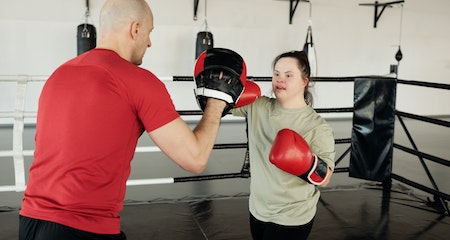A lack of physical activity can prevent people with disabilities from living an active lifestyle. This is particularly true for people with intellectual and physical disabilities. Research has shown that physical activity promotes health and prevents disease. However, there are some barriers that prevent people with disabilities from participating in physical activity. The following articles explore physical activity for people with disabilities.
Adapted physical activity for disabled
Physical activity is an essential part of a healthy lifestyle, and incorporating adaptations into physical activities can make them more accessible to people with independent disability services. People with disabilities are often less active than their non-disabled peers, leading to lower levels of activity and higher rates of obesity. The following are examples of adaptations for physical activities for people with disabilities.
For people with disabilities, physical activity is not just about exercising, but also about developing motor, physical, and physiotherapy skills. Often, they are not able to exercise with others, or participate in social activities, such as sports. This can lead to a lack of enjoyment in physical activity.
Logistic regression analysis for physical activity for disabled
The findings from this study show that the level of physical activity recommended for the disabled is associated with a reduction in the risk of disability. Specifically, physical activity is associated with a lower risk of disability in older adults. These results suggest that the recommended level of physical activity is also associated with a reduction in the risk of depression.
Logistic regression is a statistical method that includes both time-varying and baseline variables. The time-varying variables include baseline and treatment history. A logistic regression model predicts the relationship between the treatment and the outcome. By entering time-varying and baseline variables, it is possible to find a model that takes into account the risk of disability.
A logistic regression analysis also shows that the likelihood of meeting physical activity guidelines has increased with age, although the relationship is less strong than that in bivariate analysis. Among men, the odds of meeting the guidelines increased from age 16 to 44 and then declined to age 64. At age 65 and older, the odds increased again.
In contrast, physical activity levels among adults with disabilities were lower than in adults without disabilities. Only one-fourth of those with a disability reported participating in two or more activities compared to 61% of those without disabilities. Furthermore, a greater percentage of adults with disabilities reported participating in physical recreation and sport only, compared to their peers with no disability. However, their overall participation in leisure-time physical activity was lower.
Evidence on physical activity for disabled adults
Physical activity has been shown to improve health, prevent disease, and promote functional independence in persons with disabilities. However, evidence from population-based surveys suggests that persons with disabilities are less likely to engage in physical activity than the general population. In addition, the methods used to measure physical activity may not be sensitive enough to persons with disabilities. However, there are numerous studies demonstrating that persons with disabilities can increase their physical activity levels through interventions.
Physical activity guidelines for disabled adults suggest that people should aim for at least 150 minutes of physical activity per week. However, achieving this target can be difficult for people with disabilities, since they often have difficulties walking and cannot be active for long periods. In addition, the lack of transportation to community fitness facilities may be a challenge. Furthermore, many fitness centres lack accessible equipment, classes, and programs for people with disabilities.
To overcome these barriers, the UK is launching new resources to support disabled people in getting more active. A new evidence review is underway, which will include the benefits of physical activity for disabled adults. This study will be similar to the one that was conducted for children. The new guidelines will recommend the amount of activity that a person should engage in each week, as well as what types of activities should be undertaken. The review will publish its findings by mid-November 2021.
The prevalence of disability varies from country to country, with some countries being more advanced than others in promoting healthy lifestyles. Two countries that stand out in this regard are the United States and Mexico. While the US population started ageing much earlier than Mexico’s, under more favorable economic conditions, Mexico’s population is growing at a much faster rate. The best evidence approach has shown that exercise improves muscle strength and reduces functional limitations in adults with disabilities. The literature review also shows that physical activity in the late stages of life can improve physical function, aerobic capacity, and flexibility.
Barriers to participation in physical activity for people with disabilities
Many people with disabilities experience low levels of physical activity and sedentary lifestyles, making it crucial to find ways to promote physical activity. Inactivity also contributes to the development of secondary conditions such as depression, low functional capacity, low self-esteem, and fatigue. Furthermore, inactivity can lead to pressure sores and other health complications.
According to the World Health Organization (WHO), roughly 60% of adults worldwide do not engage in any physical activity. This figure is higher among those with disabilities, older adults, and people from lower socioeconomic groups. However, there is a limited amount of information available on the physical activity patterns and participation rates of people with disabilities. These are subject to a range of factors, and removing barriers to physical activity can lead to higher participation rates.
Physical activity and sport play an important role in people’s lives. Nevertheless, barriers and incentives can make it difficult for people with disabilities to engage in physical activity and sport. By removing these obstacles, people with disabilities can participate in physical activity and sports at any stage of their lives.
A study conducted by the Market Research Bureau of Ireland found that individuals with disabilities face several barriers to physical activity. These include stereotypes about their poor health or poor quality of life. These stereotypes can lead to discrimination and prejudice. Moreover, people with disabilities are twice as likely to avoid physical activity than people with no disabilities.
Increasing knowledge about the barriers to participation in physical activity for people with disabilities is necessary for developing inclusive physical activity programmes. These programmes should involve a multi-agency approach to ensure a quality physical activity experience for all. This means involving various government departments and organizations, which are crucial to the success of any intervention.

